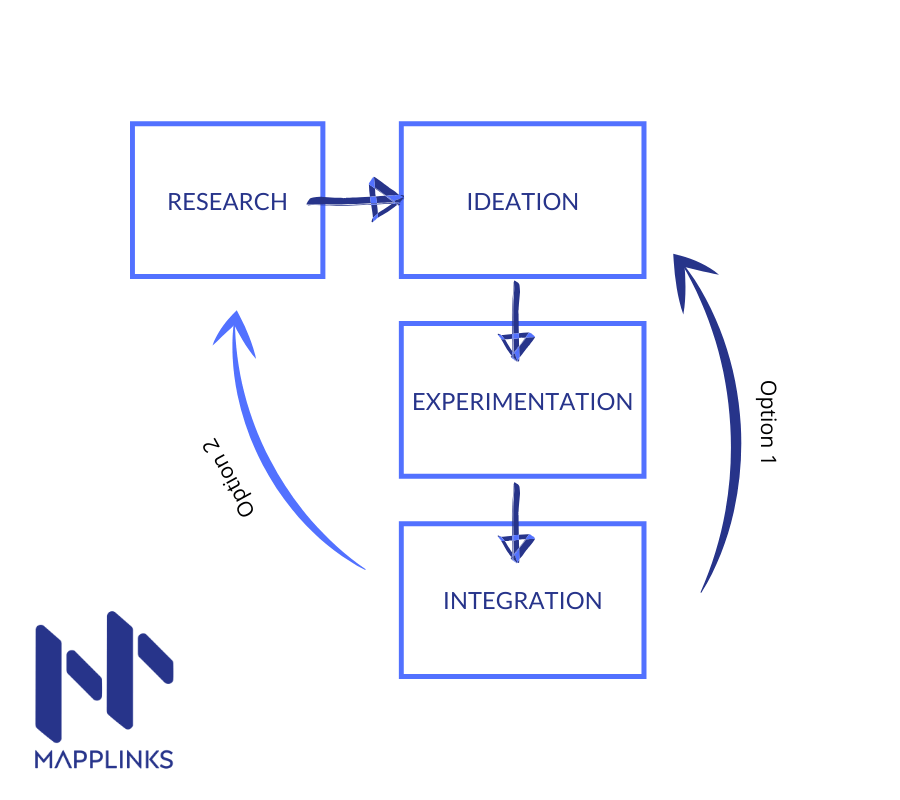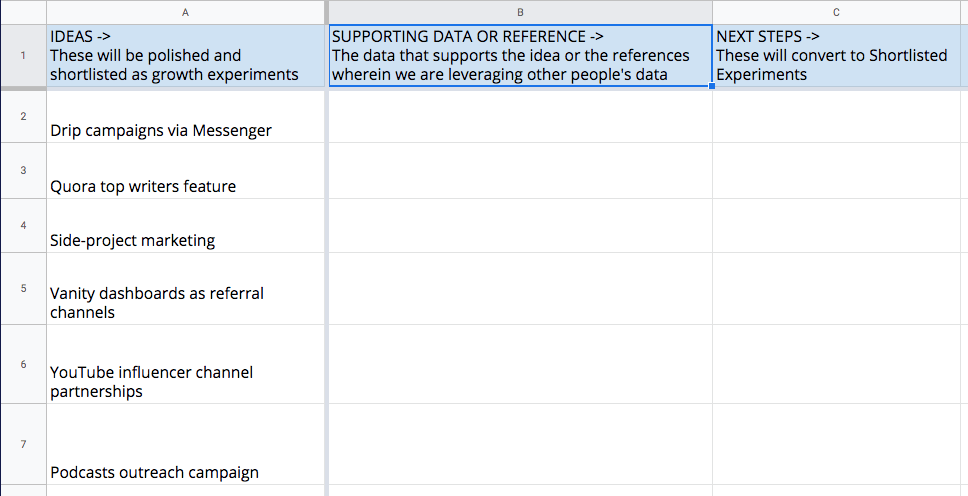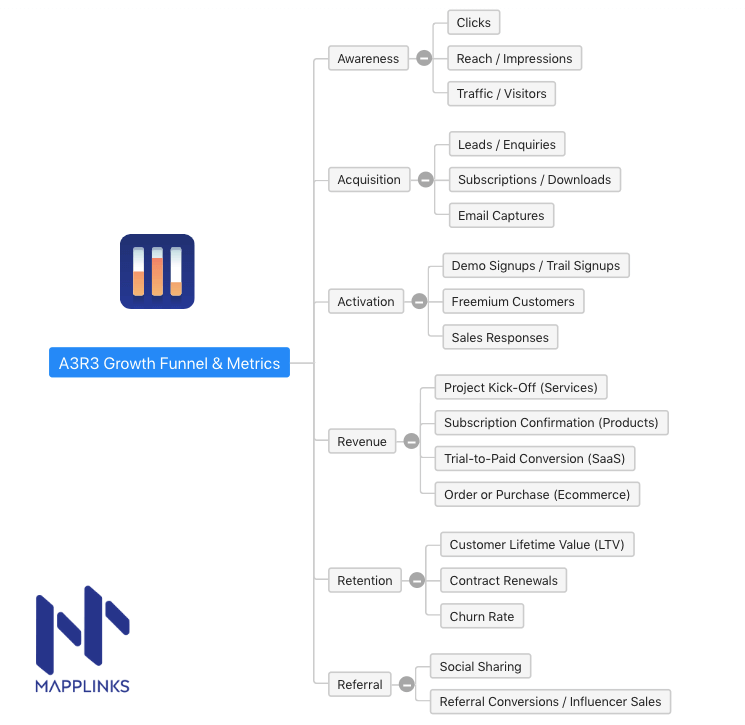Growth Marketing Process
My approach to growth marketing is extremely agile, experiment-driven, and data-oriented. I have created what I call “the bulletproof growth marketing process” which has been adopted by the likes of educational institutes such as the National University of Singapore, IITs, and IIMs, startup hubs like Station F and NUMA, and large corporations like Phillips & Java.
I started executing growth experiments with a basic foundational process and developed the process over time with learnings and experience, that I implemented in the form of process improvements over time.
The main phases of the growth marketing process are:
- The RESEARCH Phase
- The IDEATION Phase
- The EXPERIMENTATION Phase
- The INTEGRATION Phase

Growth Marketing Phase 1: RESEARCH
The steps in this research phase include:
- Deep dive into the existing data to find valuable data points
- Questionnaires with the startup founders and teams to dig for both qualitative and quantitative data
- Collecting all the data along with observations in a growth marketing research template

The Research Phase usually starts with a questionnaire.
This is a pre-growth marketing phase that involves a questionnaire to be filled by the founder or business owner or key decision-maker.
Questions vary from business to business and are designed based on the first interaction with the business. They may be different for each business based on their requirements and where they’re currently at in their startup or business phase.
With time, experience, and lots and lots of DATA, your gut feeling guides you to ask the right questions to your clients which then leads you to the right growth experiments.
A “right” growth experiment, here, refers to one that helps you achieve the desired OMTM and is scalable either by automation or by integration. (More on this in the Integration phase)
To help you reduce experimentation time, see faster results, and find your unicorn earlier, I’ve shortlisted my top 10 questions I ask all my clients before diving into the creative process of designing their growth experiments:
- Q1. If you were given just one month to grow your startup or business, what would you focus on improving the most?
- Q2. What is the best definition of your audience based on the existing customers?
- Q4. If you were the end-user for your product or service, what would you find most valuable in it?
- Q5. What is the single most important metric you want to improve with this campaign?
- Q6. Name 5 businesses that have the same audience as yours?
- Q7. What were the top 3 channels of acquisition for your first set of users?
- Q8. If you were your end-user, what other platforms would you use?
- Q9. If you were the end user and were told the product or service has discontinued, what would you miss about it the most?
- Q10. Tell me everything about the 5 most active users of your product.
However, one of the essential outputs of this phase is to establish the North Star metric or the OMTM for the business as well as draft the channel personas for the growth campaigns.
Growth Marketing Phase 2: IDEATION
Using the data from Phase 1 to list growth marketing ideas
- Fetching ideas with past data available from my database of growth marketing ideas (You should maintain a database of ideas)
- Brainstorming the ideas internally and externally (especially if you’re a growth marketing service provider or consultant)
- Assigning supporting data points to each idea
- Mapping each idea to the target growth metric
Supporting data points must be assigned to each ideas as shown in my template below:

As you can see in the ideation template, we have the following columns in this phase:
- IDEAS
- SUPPORTING DATA OR REFERENCE
- NEXT STEPS
The output of this phase is coming up with the first set of growth experiment ideas (Usually around 10 ideas). The ideas are documented based on past data, channel personas, and marketing ideas. Channel personas, like user personas, are created based on the inputs received from the business in the Questionnaire Phase.
Channel personas are characteristics of the potential new channels we can explore for growth marketing campaigns as we start thinking outside of the most popular channels.
Growth marketing is effective when we execute creative experiments on popular channels and it’s also effective when we execute regular experiments on offbeat channels.
The reasons for going beyond the popular channels are as follows:
- The most popular channels are expensive and saturated
- There are higher chances for successful growth hacking experiments in channels which are in the early-adopters peak
- A channel’s effectiveness typically reduces over time
- Offbeat and new channels are mostly cheaper than saturated ones, thus reducing investment and increasing the growth marketing ROI
- Multiple micro-channels mapped with the Target Audience are better than a single macrochannel with no TA focus
- It’s easier to target the right user segment with micro-channels VS paying for targeting on Facebook or other larger channels
- A new or offbeat channel probably has loopholes which Growth Hackers can leverage on compared to a mature channel
A few questions to help create the channel personas business are as follows:
- Q1. What kind of problem would the channel solve for a similar target audience as yours?
- Q2. What are the other interests of your target audience? Where do people with similar interests hang out online?
- Q3. What are some of the other brands, products, or tools your audience follows on social media?
- Q5. What are the new channels which have been trending on Google Play or the App Store for the past few weeks?
- Q6. What are the new communities or networks on ProductHunt or BetaList?
- Q7. Which platforms and marketplaces have recently received PR or funding?
- Q8. Which tools or networks are review bloggers in my network also writing about?
Though this is not an exhaustive list, it’ll give you a deeper understanding of how I come up with my growth marketing experiments
Growth Marketing Phase 3: EXPERIMENTATION
The steps in the experimentation phase include:
- Shortlisting ideas and moving them to the experiments list
- Defining the duration of each experiment test (the initial cycle of execution)
- Ranking the experiments in order of priority (use the metric and a framework such as ICE to do this)
- Decide a success score for each experiment that’ll help us decide if it’s successful or not
- Analyze the success score at the end of the test cycle
This is where my ideas get tested in my “growth hacking lab”. I use multiple frameworks including the most popular ICE framework to rank ideas. I’ve also created and adopted a dual ICE score methodology from both my team and the client’s team to get us the most optimal output score.
This is also the phase where I assign the stage of the growth marketing funnel to which the experiments belong.
While the popular funnel used by growth marketers is the pirate funnel, I use my own modification on the funnel which I call the A3R3 funnel.

The 6 stages of the A3R3 growth funnel as are follows:
- Awareness
- Acquisition
- Activation
- Retention
- Revenue
- Referral
Note: If you’re a very new startup, you can also use Validation Marketing first before even thinking about the growth funnel.
The Experimentation Phase is also where the hustle happens. At Mapplinks, I usually assign a team of 3 people for each execution cycle. We keep our execution cycles up to 45 days per growth marketing experiment. The team is put together based on the requirements of the experiment.
The team is also assigned so we have the right marketing, tech, copy, and analyst skills as needed. T-shaped marketers are selected based on the level of skill needed for the experiment.
The execution review happens daily and weekly. The weekly review happens over an online meeting with the client while the daily review usually happens internally.
Each week, we discuss the OMTM and how it’s improving.
For example, here’s a screenshot from the weekly OMTM tracking for an influencer outreach campaign and the ratios we measure:

During all the weekly review sessions, adjustments are made to the experiments to improve results and fine-tune the process.
Growth Marketing Phase 4: INTEGRATION
The steps in this phase include:
- Create a blueprint system of the successful experiment
- Assign an internal / freelancer / outsourced team to study the blueprint
- Decide repetition frequency and budgets against ROI
- Use tech to scale the components of the system that can be automated
- Integrate the blueprint into your business process
Important points to note:
- Analytics is not a separate phase in the process but a part of each phase. This is a big change I made to the overall growth marketing process over the past year.
- Analytics starts from Day 1 of growth marketing and continues until Integration and beyond.
- Integration includes the Scaling phase as a part of it and the new Integration phase has a scope much bigger than just scaling and automation.
- Post integration, you can go back to the idea bank (option 1) or go back to the research phase (option 2) if there have been major changes to the data collection and you need to re-do the ideation phases again.
More on Growth Marketing Analytics:
I prefer to keep a lean approach to analytics. I define the North-Star metric but I also have 3 additional metrics that directly or indirectly impact the startup’s north star. This is to improve visibility of how much we’re going to impact our North Star and by what means.
Here are some of the metrics you can measure in each stage of the A3R3 funnel.

We measure these every week and at the end of the 45 days’ execution cycle, we calculate something we call the “Experiment Success Ratio” which is a final ratio that tells us how successful the experiment went. This is our own addition to the North Star metric and this helps us assign a final score to the experiment that can be compared with other experiments even if the other experiments have a different North Star metric.
The reason I use this ratio is two-fold. One, this helps us internally keep track of how well we’re improving in our growth experiments and two, it helps the clients understand which experiments can be scaled or repeated based on their success ratios vs other experiments that may have also improved the North Star metric.
In some cases, an experiment with a lower ESR might improve the metric more than another experiment with higher ESR. In this case, we know it’s about the volume of execution and we might choose to increase the volume of the second experiment rather than repeating the first one.
This is a key metric that we’ve defined and is another of our improvement in the growth marketing process.
Based on all the data, we can repeat or scale the successful experiments. We can also repeat the entire process in parallel to test new ideas in our growth lab!


